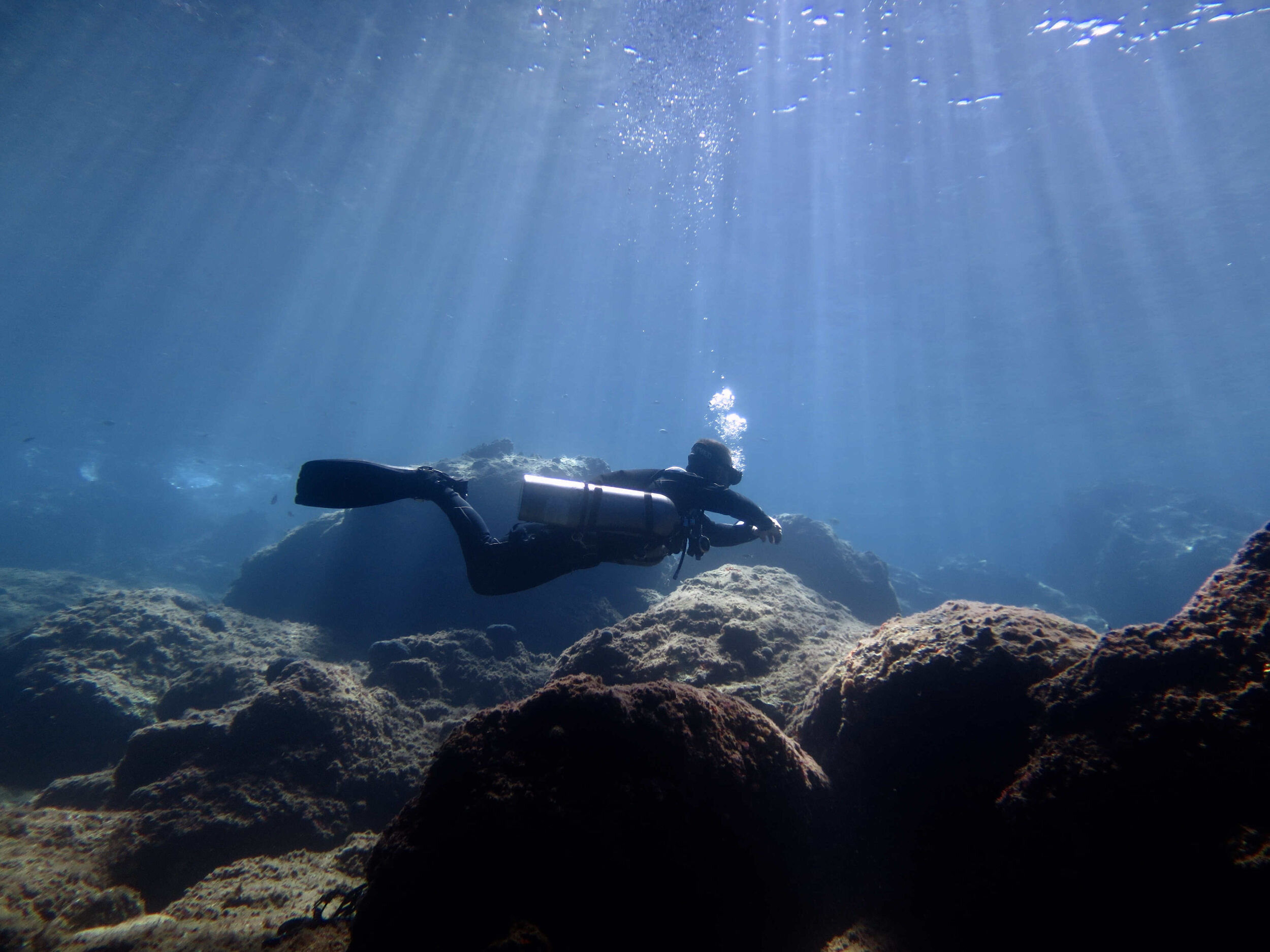OUR DIVE SPOTS
Cycladic Diving has nearly 20 different dive spots on the south west coast of Paros, on the south coast of Antiparos and on the small islands in between. The dive sites are ideal during north wind days and when Meltemi blows in July and August. We have exceptional visibility all year around.
Tripiti
The dive site is located in then most beautiful and untouched part of the south coast of Paros. The boat stops in front of a scenic arch that rises over the sea, created when a cavern roof partially collapsed. Underwater the light coming trough the arch creates a breath taking effect. The sea bottom has huge rocks with a lush posidonia meadow (Posidonia oceanica ) and walls with multicoloured cracks. Small lobsters and octopuses live in the big monoliths and many different small fishes swim around. In the most fascinating crack in between 18 m and 6 m we find different species of sponges and coralline algae and often the squirrel fish (Sargoncentron rubrum) from the Red Sea. The safety stop on the wall is also very interesting, with fresh water springs and Leopard slugs (Peltodoris atromaculata).
Distance by boat: 10min | Level: Any | Max Depth: 20m
Poseidon Eye
Our southern dive spot on Paros and one of the most interesting for geology. The sea bottom looks like the surface of the moon, with its white calcareous blocks and white walls. There is also a relaxing and healthy Posidonia meadow (Posidonia oceanica). We can find beautiful fan worms (Sabella spallanzanii), fire worms (Hermodice carunculata) and clouds of damsel fishes (Chromis chromis) swimming in the deep blue. For advanced divers at 23 meters some broken amphora remain from an ancient wreck dating from the classical age.
Distance by boat: 15min | Level: Any | Max Depth: 30m
Preza
Preza is a small island in the channel in between Paros and Antiparos. In spring it is an important nursery for sea gull and cormorants. The bottom has Posidonia (Posidonia oceanica ), sand patches and rocks covered by encrusting bryozoa, big bath sponges (Spongia officinalis) and hydroids. In some seasons it is possible to observe nice nudibranchs such as Flabellina affinis and Cratena peregrina. Good fun is to be had spotting octopuses and small scorpion fishes (Scorpaena notata). There are always big school of different sea breams (Diplodus vulgaris et Oblada melanura ) and sometimes barracudas (Sphyraena viridensis). Close to the wall in 7/9 meters there are beautiful light effects, yellow corals (Leptosammia pruvoti), cardinal fishes (Apogon imberbis) and parrot fishes (Sparisoma cretense).
Distance by boat: 10min | Level: Any | Max Depth: 15m
Panderonisi Cavern
Panderonissi island is testimony of the geological history of the Aegean Sea. The lime stone has been carved by fresh water for thousands of years, since the time when Cyclades were a single “mega island”, and for this reason we can find many cavities on the bottom. The cavern a simple dive concerning the inner space and the passages, but good buoyancy skills are required in order to avoid damaging the life in the cave and on its wall. There are three entrances. The main one is huge in between 12 meters (the max depth of the cave) and 4 meters, the second is smaller but still easily accessible and the third is more technical. The bottom is dusty and rocky, perfect for big tube anemones (Pachycerianthus solitarius ). The walls are like a very colourful fresco: red and purple sponges, pink coralline algae and tiny yellow solitary corals (Leptosammia pruvoti). It is possible to surface inside the cavern where the process of forming stalactites is still active and the blue light coming from the bottom is breathtaking. The cavern is just one of our dive sites around Panderonissi. On the other side of the island there is Amphitritis Cave (explored for the first time by the team of Cycladic Diving and possible to dive for fully qualified technical cave divers) and Amphitheaters, an easy and relaxing dive for all the levels with very interesting geological aspects. Outside the caverns it is possible to guide different deep dives. At 25/30 meters we often observe dusky groupers (Epinephelus marginatus) and golden-botch groupers (Epinephelus costae).
Distance by boat: 10min | Level: Advanced | Max Depth: 30m
Jacquarium
A beautiful reef with a drop off in the middle of the sea, close to the superb Blue Lagoon. There is a platform at 10 meters with a vertical descent to the deepest part. Different species of groupers, sea breams and snappers (Dentex dentex ) can be found here, as well as occasionally amberjacks (Seriola dumerili) and barracudas (Sphyraena viridensis).
Distance by boat: 15min | Level: Advanced | Max Depth: 40m
Labyrinth
This is one of our favorite dive site in Antiparos. It’s an open reef on the southern point of the island where canyons and gorges create a scenic bottomscape. The reef is rich in sea slugs (Cratena peregrina, Flabellina affinis, Flabellina ischitana ) whic are feeding and laying eggs on hydroids. We usually see large schools of sea breams (Diplodus vulgaris and Sarpa Salpa) and picarels (Spicara smaris) in mid water. In the cracks we can find spiny spider crabs (Maja squinado) and morays (Muraena helena).
Distance by boat: 25min | Level: Any | Max Depth: 25m
Minoan Reef
This is a nice reef detached from the south coast of Aliki. The bottom here is different from any other dive, its profile like a mountain range covered by brown algae Cystoseira sp. Often spotted are big hatpin urchins (Centrostephanus longispinus). We always see hundreds of damsel fishes (Chromis chromis) hanging under the surface. There are also some interesting remains of pottery from the third century BCE.
Distance by boat: 10min | Level: Any | Max Depth: 20m







